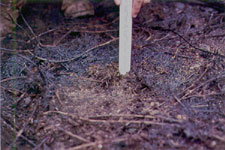Lifestyle and Adaptations

Not much information is available about the specific biology and the
history of Mystery Vertigo. Looking at land snails together, we
know that they require adequate moisture, shelter, a food
supply, and a source of calcium to maintain their shell
(Sterki, 2007). These factors can
cause a land snail to display limited dispersal and patchy
distribution because of a sensitivity to environmental
conditions
(Sterki, 2007). Such environmental
conditions that could play a role are temperature, moisture, and
other activities that may alter the land, such as fire, mining,
or grazing
(Anderson, 2004).
Fire can greatly diminish the
species population.
Because of the patchy distribution that can be
caused by many factors, some populations of land snails that are
a kilometer apart or less, could be considered
isolated individuals
(Anderson, 2004).
Water is required by land snails for basic physiological processes,
such as locomotion and reproduction. Most of the land snails can
minimize their water loss by closing their shell opening with an
operculum
(Sterki, 2007). The ability of a
land snail to do this helps them survive dry conditions when
water is not readily available
(Sterki, 2007).

Snails require calcium to maintain their shells. Because of this, snails
are most commonly found in habitats that are rich in calcium
(Sterki, 2007). Some areas where calcium is abundant is in
limestone, in areas that have soil that is derived from
limestone, or areas that have high levels of calcium carbonate
(Sterki, 2007). Some snails are
found in areas where the calcium content in the soil is poor and it is believed that
the snail acquires the calcium needed from the local vegetation
around them
(Sterki, 2007). In this case, the snails would scrape rocks, other snail shells or ingest soil in order to obtain the
calcium they needed
(Sterki, 2007). Another way that calcium can be obtained by
the snail is through calcium dissolved in water that the snail
can get by drinking or absorbing the water through their skin
(Sterki, 2007).
Mii Photos.
Limestone

Availability of adequate shelter or refuge is also extremely
important to land snails. Burch and Pearce (1990) have suggested
that the most limiting factor limiting the abundance of land
snails is refuges (Sterki, 2007). Refuge
can provide shelter from cold and
hot weather conditions as well as protection
from predators. Refuge can include leaf litter, rotting
logs and other woody debris,
rocks, and under the soil surface. Most land
snails also survive the winter underground or under rocks, logs,
and boards (Sterki, 2007).
Woody debris provides good refuge for
land snails.

Vertigo paradoxa, among some other land snails, have shown to
respond strongly to differences in soil depth and composition
(Nekola, 2003). It has been found
that other land snails in the Great Lakes region, including the
Mystery Vertigo, prefer soils that have a more loose upper soil
under a deep organic layer (Sterki, 2007).
Along with soil depth and composition, different snail species
prefer different amounts of ground cover, with Vertigo
species found in a variety of the different categories
(Nekola 2002 in Anderson 2004).
Soil
with duff for protection.

Some of the other primary factors that are regulating or influencing snail
activity are temperature, moisture, and light intensity
(Sterki, 2007). Land snails may be
active during the day following rain, even though land snails are
primarily nocturnal
(Sterki, 2007). It has also been
seen that land snails respond to a high relative humidity and
cooler temperatures by becoming more active, as most land snails
do not move too much other than to find food or to reproduce
(Sterki, 2007). Migration is most
commonly seen only under favorable environmental conditions
because land snails tend to migrate fairly slowly over a very
short distance
(Sterki, 2007).
Light
intensity can influence snail activity.
Reproduction - Home - Endangered Species